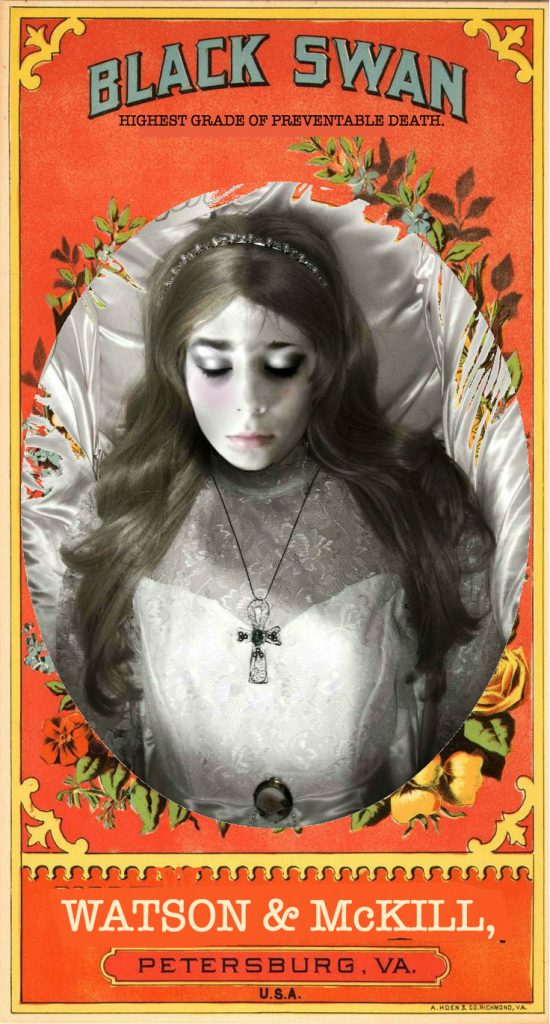Welcome to UBC Blogs. This is your first post. Edit or delete it, then start blogging!
Culture Jamming Assignment
ORIGINAL AD

ANALYSIS
Though this vintage cigarette ad (1870) created by Watson & McGill differs from modern ads in many ways, it is no less susceptible to the practice of culture jamming. While newer ads often depict “ideal” lifestyles (socialite, glamorous, relaxed,) or personality traits of users (classy, assertive, powerful, charming) in direct and obvious ways, Black Swan cigarettes take a slightly different but equally problematic approach.
Firstly, the simplicity of the design reinforces the reputation of a company that specializes in manufacturing high quality products and nothing else, encouraging consumers to blindly trust what they smoke without examining external consequences. While this lends much credibility to Watson & McGill, they exploit this by distracting the consumer from the health risks associated with smoking – the primary problem to be addressed in this ad.
There is a complete lack of information on the dangers of tobacco usage. In fact, the ad’s heavy reliance on the regal aesthetic of their poster seems to allude instead to an image of health and wealth. On a deeper level, it does stay true to the suggestive “lifestyle” nature of cigarette ads, as the image of the beautiful woman appeals to wealthier, socialite men. The advertisement thus makes a subtle association between status and smoking, and combined with the innocent visuals, leads the mind far away from rotting gums, clogged arteries, and scarred lungs. Since these ailments are typically associated with those of lower socioeconomic standing, the wealthy are misled to believe they are falsely exempt from such consequences. Furthermore, the youthful aesthetic (young woman, vibrant colours, fresh flowers) suggests longevity and health, which is far from truthful when it comes to even the “highest grade tobacco”. As for the usage of text, the single line featured in this ad relies on the simplicity of a seemingly factual statement in order to reinforce the quality of its product and thus distract from the bigger health problem. It’s almost like selling the idea of their own intelligence to the consumers – there is no need for Watson & McGill to “beguile” them through complicated advertising because the socialites are far are too smart for that; the “truthful” selling points of the product can stand on its own two feet, which is cleverly dishonest since it completely distracts from the elephant in the room (health risk).
JAMMED AD

EXPLANATION
The philosophy behind my jamming was to emphasize the high morbidity rate associated with smoking that Watson & McGill completely ignored in their advertisement. By replacing the image of the woman with her deceased casket-ridden counterpart, I took special care to choose one who paralleled the original woman in many ways; from her youthful beauty to elegant attire, everything is strikingly similar except for her vitality in order to make a stronger visual impact. It is clearly uncomfortable and unnatural to relate associate death with youth, but this image is meant to bring out the detriments that Watson & McGill distract from in the most obvious way possible.
Furthermore, by editing the text to show that “tobacco” is synonymous with “preventable death”, it sends a clear message that the choice to smoke will likely lead to an unglamorous outcome (to put it lightly). However, the use of the word “preventable” is also important in communicating that smoking is in fact, a decision consumers are free to make, regardless of their social class or other lifestyle attributes. While the original ad suggested that smoking is a harmless habit that is expected of socialite classes, the jammed version aims to show the truth and free them from restrictive social pressures.
The final form of subversion replaces the name “McGill” with “McKill” with the simple purpose of making the jammed ad easier to remember. The company’s name is associated with specialized, high-end goods, and by subtly reminding consumers of the dark nature of these products (regardless of the promising quality), smokers are encouraged to make more informed decisions about their health. The strength of the original ad lay in its seemingly simple and factual nature and I aimed to emulate their approach while communicating the blatant dangers that Watson & McGill tried to hide. The fact that smoking is among the leading causes of preventable death (“Fast Facts.” Centers for Disease Control and Prevention. Centers for Disease Control and Prevention, 20 Dec. 2016. Web. 16 Feb. 2017.) is significantly more important for consumers to know than the fact that a company uses high quality tobacco, as is the fact that smoking kills people of all ages.